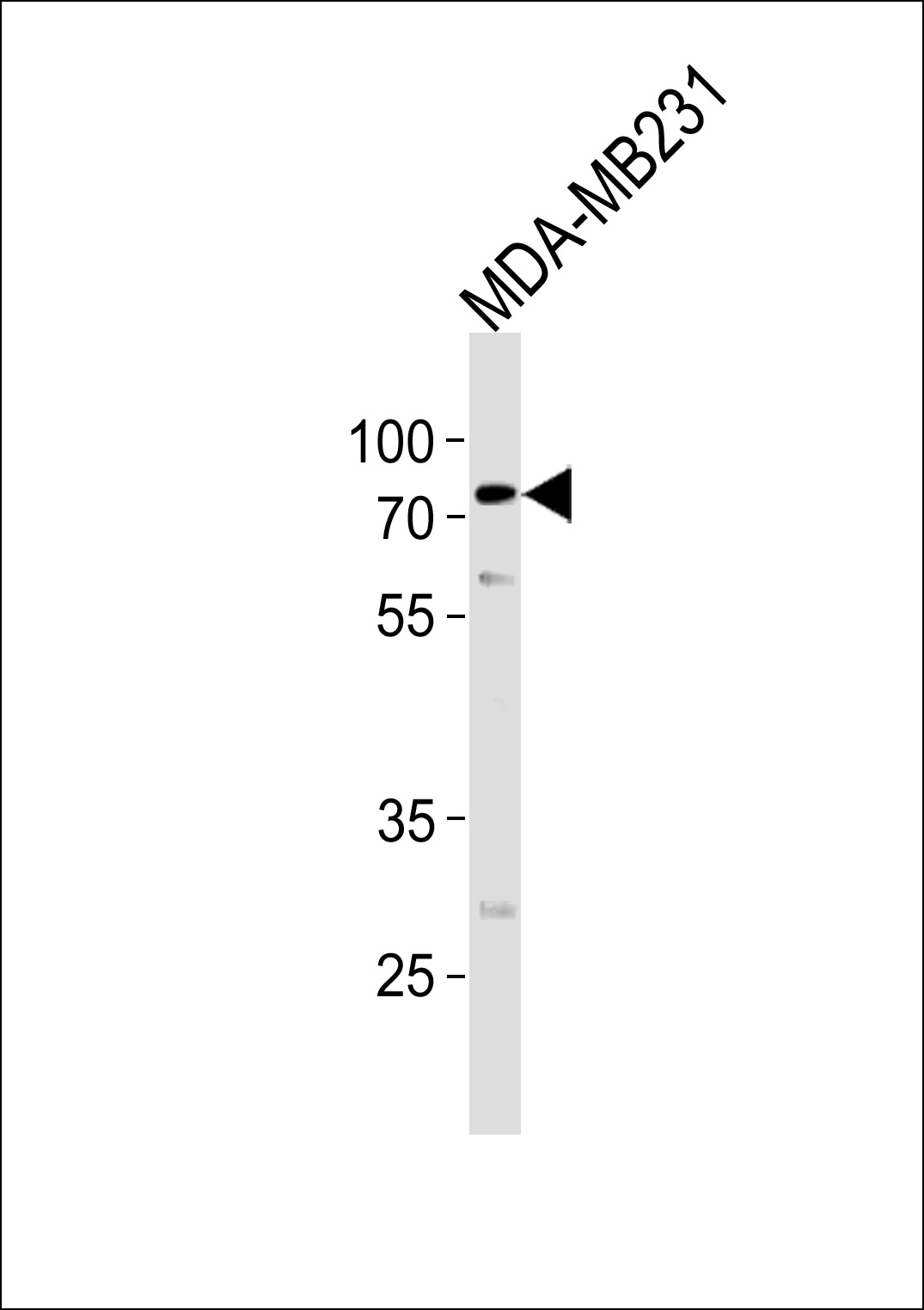TRIM25 Antibody (Center)
Affinity Purified Rabbit Polyclonal Antibody (Pab)
- 产品详情
- 实验流程
- 背景知识
Application
| WB, E |
|---|---|
| Primary Accession | Q14258 |
| Other Accession | NP_005073.2 |
| Reactivity | Human |
| Host | Rabbit |
| Clonality | Polyclonal |
| Isotype | Rabbit IgG |
| Calculated MW | 70973 Da |
| Antigen Region | 277-306 aa |
| Gene ID | 7706 |
|---|---|
| Other Names | E3 ubiquitin/ISG15 ligase TRIM25, 632n3, Estrogen-responsive finger protein, RING finger protein 147, Tripartite motif-containing protein 25, Ubiquitin/ISG15-conjugating enzyme TRIM25, Zinc finger protein 147, TRIM25, EFP, RNF147, ZNF147 |
| Target/Specificity | This TRIM25 antibody is generated from rabbits immunized with a KLH conjugated synthetic peptide between 277-306 amino acids from the Central region of human TRIM25. |
| Dilution | WB~~1:1000 E~~Use at an assay dependent concentration. |
| Format | Purified polyclonal antibody supplied in PBS with 0.09% (W/V) sodium azide. This antibody is purified through a protein A column, followed by peptide affinity purification. |
| Storage | Maintain refrigerated at 2-8°C for up to 2 weeks. For long term storage store at -20°C in small aliquots to prevent freeze-thaw cycles. |
| Precautions | TRIM25 Antibody (Center) is for research use only and not for use in diagnostic or therapeutic procedures. |
| Name | TRIM25 |
|---|---|
| Synonyms | EFP {ECO:0000303|PubMed:8248217}, RNF147 |
| Function | Functions as a ubiquitin E3 ligase and as an ISG15 E3 ligase (PubMed:16352599). Involved in innate immune defense against viruses by mediating ubiquitination of RIGI and IFIH1 (PubMed:17392790, PubMed:29357390, PubMed:30193849, PubMed:31710640, PubMed:33849980, PubMed:36045682). Mediates 'Lys-63'-linked polyubiquitination of the RIGI N-terminal CARD-like region and may play a role in signal transduction that leads to the production of interferons in response to viral infection (PubMed:17392790, PubMed:23950712). Mediates 'Lys-63'- linked polyubiquitination of IFIH1 (PubMed:30193849). Promotes ISGylation of 14-3-3 sigma (SFN), an adapter protein implicated in the regulation of a large spectrum signaling pathway (PubMed:16352599, PubMed:17069755). Mediates estrogen action in various target organs (PubMed:22452784). Mediates the ubiquitination and subsequent proteasomal degradation of ZFHX3 (PubMed:22452784). Plays a role in promoting the restart of stalled replication forks via interaction with the KHDC3L-OOEP scaffold and subsequent ubiquitination of BLM, resulting in the recruitment and retainment of BLM at DNA replication forks (By similarity). Plays an essential role in the antiviral activity of ZAP/ZC3HAV1; an antiviral protein which inhibits the replication of certain viruses. Mechanistically, mediates 'Lys-63'- linked polyubiquitination of ZAP/ZC3HAV1 that is required for its optimal binding to target mRNA (PubMed:28060952, PubMed:28202764). Also mediates the ubiquitination of various substrates implicated in stress granule formation, nonsense-mediated mRNA decay, nucleoside synthesis and mRNA translation and stability (PubMed:36067236). |
| Cellular Location | Cytoplasm. Cytoplasm, Stress granule. Nucleus {ECO:0000250|UniProtKB:Q61510} |
| Tissue Location | Expressed in breast tumors (at protein level). Ubiquitous. |
For Research Use Only. Not For Use In Diagnostic Procedures.
Provided below are standard protocols that you may find useful for product applications.
BACKGROUND
The protein encoded by this gene is a member of the tripartite motif (TRIM) family. The TRIM motif includes three zinc-binding domains, a RING, a B-box type 1 and a B-box type 2, and a coiled-coil region. The protein localizes to the cytoplasm. The presence of potential DNA-binding and dimerization-transactivation domains suggests that this protein may act as a transcription factor, similar to several other members of the TRIM family. Expression of the gene is upregulated in response to estrogen, and it is thought to mediate estrogen actions in breast cancer as a primary response gene.
REFERENCES
Dai, H., et al. Oncol. Rep. 23(3):795-799(2010)
Zhao, J., et al. BMC Med. Genet. 11, 96 (2010) :
Gack, M.U., et al. Cell Host Microbe 5(5):439-449(2009)
Ludwig, S., et al. Cell Host Microbe 5(5):420-421(2009)
Dai, H., et al. Oncol. Rep. 21(2):395-401(2009)
终于等到您。ABCEPTA(百远生物)抗体产品。
点击下方“我要评价 ”按钮提交您的反馈信息,您的反馈和评价是我们最宝贵的财富之一,
我们将在1-3个工作日内处理您的反馈信息。
如有疑问,联系:0512-88856768 tech-china@abcepta.com.























 癌症的基本特征包括细胞增殖、血管生成、迁移、凋亡逃避机制和细胞永生等。找到癌症发生过程中这些通路的关键标记物和对应的抗体用于检测至关重要。
癌症的基本特征包括细胞增殖、血管生成、迁移、凋亡逃避机制和细胞永生等。找到癌症发生过程中这些通路的关键标记物和对应的抗体用于检测至关重要。 为您推荐一个泛素化位点预测神器——泛素化分析工具,可以为您的蛋白的泛素化位点作出预测和评分。
为您推荐一个泛素化位点预测神器——泛素化分析工具,可以为您的蛋白的泛素化位点作出预测和评分。 细胞自噬受体图形绘图工具为你的蛋白的细胞受体结合位点作出预测和评分,识别结合到自噬通路中的蛋白是非常重要的,便于让我们理解自噬在正常生理、病理过程中的作用,如发育、细胞分化、神经退化性疾病、压力条件下、感染和癌症。
细胞自噬受体图形绘图工具为你的蛋白的细胞受体结合位点作出预测和评分,识别结合到自噬通路中的蛋白是非常重要的,便于让我们理解自噬在正常生理、病理过程中的作用,如发育、细胞分化、神经退化性疾病、压力条件下、感染和癌症。






